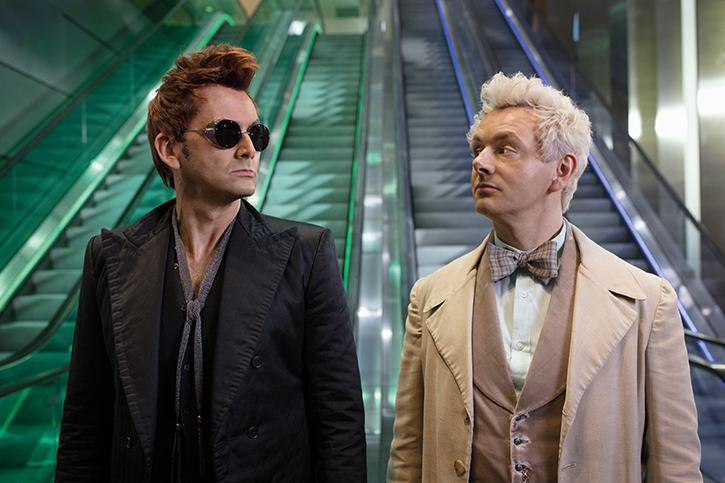
It’s Raining Men, Omen
Posted on May 24, 2019 by Alex Fice
Or does the apocalypse bring raining locusts? We talk to DOP Gavin Finney about how he created the aesthetic for the impending end.
Words Roger Payne / Pictures Amazon Prime Video & Gavin Finney
Good Omens was written as a bit of fun between two young friends, who later went on to become Neil Gaiman and Sir Terry Pratchett. Next year, Good Omens turns 30, and in those three decades, it has sold millions of copies around the world and is – at Pratchett’s last wish – currently being adapted for television.
Gaiman previously said he would not adapt the 1990 fantasy novel without Pratchett, who sadly died in March 2015 from a rare form of Alzheimer’s disease. The long-time friends and co-authors had bargained from the offset that all things Good Omens would be worked on together.
But in a memorial event for Pratchett, a year on from his death, Gaiman announced to whistles and cheers that he personally would be adapting the novel for television. He explained that he had been spurred to change his mind after receiving a posthumous letter from Pratchett, requesting that he write a screen adaptation by himself, with the late author’s blessing.
An adaptation of the novel – which finds angel Aziraphale and demon Crowley working together to try and prevent the world’s demise – has, in the past, been notoriously challenging for scriptwriters to actualise. Gaiman and Pratchett’s writing is extremely descriptive, visual and often absurd, and writers have either turned the job down or, in Terry Gilliam’s case, failed in several attempts at it.
Before Pratchett’s death, director Dirk Maggs – at Gaiman’s instigation – adapted Good Omens for BBC Radio 4, which broadcast in 2014 and included cameos from both Pratchett and Gaiman. Gaiman says he urged BBC Radio 4 to adapt it so that Pratchett could enjoy their shared creation while he was still alive.
In the six-part television series, soon to air on Amazon Prime Video, Gaiman is the scriptwriter and the showrunner. For DOP Gavin Finney, this auspicious arrangement was paramount in building the visual world of the show. “He [Gaiman] was invaluable in updating the story and making it work for the screen,” says Finney.
“Pratchett and Gaiman’s descriptions were key to the whole design aesthetic. We started with the idea that nothing was impossible, and if we could imagine it, we could do it. The range of looks throughout the series is huge. In episode three, we move through ten different time periods/locations in the first 30 minutes, and that’s not counting Heaven and Hell.”

“Heaven occupies the best penthouse offices, while Hell is stuck in a mouldy basement.”

The Guise of Time
Finney tells us that he had read Good Omens some time ago, so he had an idea of what he was getting into. “I came onto the show quite late in the day – I was on a plane to Cape Town one day after getting the job – so research was on the hoof, with many grabbed meetings between myself, the director, Douglas Mackinnon, and the designer, Michael Ralph.” He continues, “Ralph had already started design drawings and those were a starting point for everything else.”
Gaiman had strong visual ideas for the series by this point, but it didn’t make for a strict retelling of the novel; liberties had to be taken to elevate the narrative. Crowley gets a completely original 30-minute backstory at the beginning of episode three, and Shakespeare, who only has a small citing in the novel, gets an entire sequence shot at London’s Globe Theatre.

The story moves through different eras in time to tell the tale of Aziraphale and Crowley, representatives of good and evil, who have decided the upcoming apocalypse is a bad idea, not only for humanity but for their own comfy lives on Earth. To stop it, they need to find the Antichrist, an
11-year-old boy named Adam, who they have misplaced at birth. (Did we mention that Good Omens is a black comedy?)
“Each era had a different design treatment, obviously in the case of costume and production design, but also in the way that we shot each scene and the way in which they were lit. Neil had always imagined the scene in the church during the Blitz to be an homage to the film noir style of that time.”
“Ancient Rome was given the patina of an Alma-Tadema oil painting; Elizabethan London was shot in Shakespeare’s Globe Theatre; and the 1960s were shot in our Soho set, which was redressed with posters from that time. We also changed the lighting so that it used more neon and bare bulbs for the signage,” says Finney.
Gaiman wanted Heaven and Hell to feel like two parts of the same celestial building, so Heaven occupied the best penthouse offices, and Hell was stuck in a damp, mouldy basement down below, where nothing works properly.
“We found a huge empty building for the Heaven set that had shiny metal flooring and white walls. I frosted all the windows and lit them from the outside using 77 Arri Skypanels linked to a dimmer, so that we could control the light over the day. We also used a Zeiss Rectilinear 8mm lens to make the space look even bigger,” says Finney.
“The Hell set used a lot of old, slightly greenish fluorescent light fittings, some of them flickering on and off. The designer, Ralph, included slimy dark walls and leaking pipes in the mix, too” he adds.
For another scene, Finney tells us that Gaiman and Mackinnon wanted to create an old film aspect. So Arri Media in London constructed a hand-cranked digital camera out of an old Arri D21 camera, which was connected to an Arri 435 hand-crank wheel, and then to a Codex recorder.
“This gave us a realistic and organic variable speed/variable exposure look. I added some old glass in a deliberately ill-fitting mount to emulate film weave and vignette. This way, I was able to reproduce very accurately the old-style, hand-cranked black and white look of the first days
of cinema.”

Finney was given the freedom to choose whichever system he wanted, under one condition – it had to be 4K UHD capable. “I chose to shoot on Leica Summilux Primes and Arri Alura zooms (15.5-45mm and 45-2550mm), and the Arri Alexa SXT and Alexa Mini because they’re reliable cameras that are easy to work with, they look great and have low noise in the colour channels, which is useful for green/blue screen work.”
He adds, “They can also shoot at 120fps without cutting into the sensor size. The Alexa 4KH UHD output is very flexible in the grade, which was vital for us because we knew we were going to be pushing the look in a number of directions in post. We also shot with the Phantom Flex4K high speed camera at 1000fps for some scenes requiring ultra-slow motion.”
Mackinnon wanted the cameras to constantly be in motion, to lend the story a kinetic energy that would free up the third axis. This allowed Finney to soar the cameras over the actors, giving the shots a different perspective to the action below.
“To do this, we used a 50ft TechnoCrane on an off-road, self-levelling basis for the majority of the shoot; the Super Techno Crane was used on 77 days. We also employed a wire-cam to fly over the makeshift den, set in the woods, and drones were used on a number of occasions.”
“Our standard kit included two full-time Steadicam operators, one of whom (Matt Fisher) used an Alien Revolution rig to allow the camera to move from low to high angles seamlessly in-shot,” he says.

Heaven, Hell – And All That’s In Between
Good Omens is a technicolour feast for the eyes. Finney explains to us that there is a progression in the story where things start to get increasingly strange as Adam (the child Antichrist) comes into his powers and ideas in his head start to manifest.
“There is the real world as we know it, there’s Adam’s world where everything is heightened and strangely perfect, and then there is Aziraphale’s and Crowley’s world of angels and demons. At some point, all of these worlds intersect. I had to keep a lot of balls in the air with regard to giving each section its own look, but also making sure that when these worlds collide, everything still makes sense,” says Finney.
All sets, including the exteriors, had to be lit. Production occurred between September and December in the UK – which, as you can imagine, brought with it very variable weather – and from January to March in Cape Town. At one point, the enormous Soho street set had to be lit
‘night for day’ because it had become drenched in darkness at around 3.30pm,
but the crew needed to continue shooting day scenes.
 Crew and cast, including (above from left) director Douglas Mackinnon, David Tennant (Crowley), Michael Sheen (Aziraphale) and writer Neil Gaiman.
Crew and cast, including (above from left) director Douglas Mackinnon, David Tennant (Crowley), Michael Sheen (Aziraphale) and writer Neil Gaiman.
1
Hand cranked ARRI D21 digital camera
77
Days of use of a Super Techno Crane

“We used six-metre Hybrid Helium balloons – six in total – each controlled by its own crane, plus two more cranes each with two remote-controlled 18Kw HMIs.
We also had four mobile 20ft by 20ft independently lit green screens on JCB Telehandlers for set extensions.”
“The forest scenes were also lit with cranes, as was the big end sequence – no spoilers, we promise – which was filmed over eight days at an airbase. The interior sets all had dimmer controlled lighting, which often had to change in-shot,” explains Finney.
From the clips we’ve seen, it’s clear that the character and character dynamics influence a lot of Finney’s visual decisions, not least because the two main characters are an angel and a demon, two of the strongest of archetypes. In one beautiful shot, we see the lighting literally creating a halo for the angel Aziraphale.
“Each group of characters had a different look. The angel and demon were always filmed and lit to look heroic and, whilst mingling among mortals, always appear somehow heightened. The gang of kids that Adam hangs out with live a perfect life in a perfect village – it’s perfect because Adam is the Antichrist and he has special powers, although he doesn’t know that yet.”
The rushes were graded on Da Vinci Resolve with DIT Rich Simpson (who we interview next issue). Different looks were applied to each period in the story, often using a modified film emulation plug-in. For Finney, it was important that the rushes looked great to establish an early look that could inform the grade later.
Simpson helped Finney to select the right look, and was able to export the selected looks and workflow to the South African DIT in Cape Town. “This formed the starting point of the online grade done at Molinare on Baselight, under the hugely capable hand of senior colourist Gareth Spensley.”
“Spensley had a big influence over the appearance of the series. He did some fantastic work balancing all the different day exteriors and adding some real magic. He got the ambition of the show and was a great asset,” says Finney.
Finney has worked on quite a number of complex and CGI-heavy television series and films, many with fantasy elements.
“I love doing them. Good Omens was one of the biggest in terms of resource and sheer range of looks, but every job is different, and I will never stop learning and trying out new things.”

“The angel and demon were always filmed and lit to look heroic, and appear somehow heightened.”
Good Omens debuts on Amazon Prime Video on 31 May and is being co-produced with the BBC, who will show the drama after its release on Amazon. Finney tells us that Amazon backed the production of the show creatively and wanted all involved to do their best work. “They were very supportive and appreciative of what we were doing, and gave Mackinnon and Gaiman the freedom to really go to town with translating the book to screen,” he says.
Finney was about to board a plane when we last caught up with him. He’s an all work, no life kind of guy – his words, not ours!
“You try and fit a bit of life in between jobs,” he concludes. “But as I have just finished another six-month-long shoot, straight after finishing Good Omens, it does get tricky. Whenever I finish a job, it doesn’t take me long before I’m itching to do something else.”













